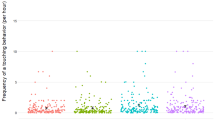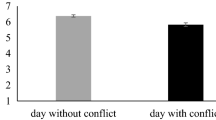Abstract
This study explores the similarity of touch behavior and touch attitudes among dating and married couples. Touch behavior showed a strong matching effect for seriously dating and married couples. Z-tests revealed that correlations between relational partners were significantly stronger for marrieds than for serious or casual daters. Results for attitudes concerning touch showed a statistically significant but weak relationship between dyadic partners though the correlation strengthened in closer relationships. As was the case in previous studies, results showed that women reported less positive attitudes toward opposite-sex touch than men. A linear contrast in proportions demonstrated that men initiated touch significantly more in casual romantic relationships, but women initiated touch more in married relationships. Together, these data suggest that patterns of matching may vary as a function of relationship stage, while patterns of touch initiation may vary as a function of both relationship stage and sex.
Similar content being viewed by others
References
Altman, I., & Taylor, D. A. (1973).Social penetrations: The development of interpersonal relationships. New York: Holt, Rinehart & Winston.
Andersen, J. F., Andersen, P. A., & Lustig, M. W. (1987). Opposite-sex touch avoidance: A national replication and extension.Journal of Nonverbal Behavior, 11, 89–109.
Andersen, P. A. (1985). Nonverbal immediacy in interpersonal communication. In A. W. Siegman & S. Feldstein (Eds.),Multichannel integrations of nonverbal behavior (pp. 1–36). Hillsdale, NJ: Erlbaum.
Andersen, P. A. (1989, May).A cognitive valence theory of intimate communication. Paper presented at the International Network Conference on Personal Relationships, Iowa City, IA.
Andersen, P. A., & Guerrero, L. K. (1989, February).Avoiding communication: Verbal and nonverbal dimensions of defensiveness. Paper presented to the annual meeting of the Western Speech Communication Association, Spokane, WA.
Andersen, P. A., & Leibowitz, K. (1978). The development and nature of the construct touch avoidance.Environmental Psychology and Nonverbal Behavior, 3, 89–106.
Argyle, M., & Dean, J. (1965). Eye contact, distance, and affiliation.Sociometry, 28, 289–304.
Berscheid, E., Dion, K. K., Walster, E. H., & Walster, G. W. (1971). Physical attractiveness and dating choice: Tests of the matching hypothesis.Journal of Experimental Social Psychology, 7, 173–189.
Blumstein, P., & Schwartz, P. W. (1983).American couples. New York: Pocket Books.
Burgoon, J. K. (1991). Relational message interpretations of touch, conversational distance, and posture.Journal of Nonverbal Behavior, 15, 233–259.
Burgoon, J. K., Buller, D. B., & Woodall, W. C. (1989).Nonverbal communication: The unspoken dialogue. New York: Harper & Row.
Burgoon, J. K., Dillman, L., & Stern, L. A. (1993). Adaptation in dyadic interaction: Defining and operationalizing patterns of reciprocity and compensation.Communication Theory, 4, 295–316.
Burgoon, J. K., & Jones, S. B. (1976). Toward a theory of personal space expectations and their violations.Human Communication Research, 2, 131–146.
Burgoon, J. K., & Hale, J. L. (1988). Nonverbal expectancy violations: Model elaboration and application to immediacy behaviors.Communication Monographs, 55, 58–79.
Burleson, B. R., & Denton, W. H. (1992). A new look at similarity and attraction in marriage: Similarities in social-cognitive and communication skills as predictors of attraction and satisfaction.Communication Monographs, 59, 268–287.
Burleson, B. R., Samter, W., & Lucchetti, A. E. (1992). Similarity in communication values as a predictor of friendship choices: Studies of friends and best friends.Southern Communication Journal, 57, 260–276.
Byrne, D. (1971).The attraction paradigm. New York: Academic Press.
Cappella, J. N. (1985). Controlling the floor in conversations. In A. W. Siegman & S. Feldstein (Eds.),Multichannel integrations of nonverbal behavior (pp. 69–103). Hillsdale, NJ: Erlbaum.
Cappella, J. N., & Greene, J. O. (1982). A discrepancy-arousal explanation of mutual influence in expressive behavior for adults and infant-adult interaction.Communication Monographs, 49, 89–114.
Cappella, J. N., & Palmer, M. T. (1990). Attitude similarity, relational history and attraction: The mediating effects of kinesic and vocal behaviors.Communication Monographs, 57, 161–183.
Duck, S., & Barnes, M. K. (1992). Disagreeing about agreement: Reconciling differences about similarity.Communication Monographs, 59, 199–208.
Eakins, B. W., & Eakins, R. G. (1988). Sex differences in nonverbal communication. In L. A. Samovar & R. E. Porter (Eds.),Intercultural communication: A reader (pp. 292–309). Belmont, CA: Wadsworth.
Fromme, D. K., et al. (1986). Attitudes toward touch: Cross-validation and the effects of gender and acquaintanceship.Passegha di Psicologia, 3, 49–63.
Guerrero, L. K., & Andersen, P. A. (1991). The waxing and waning of relational intimacy: Touch as a function of relational stage, gender and touch avoidance.Journal of Social and Personal Relationships, 8, 147–166.
Hall, J. A., & Veccia, E. M. (1990). More “touching” observations: New insights on men, women, and interpersonal touch.Journal of Personality and Social Psychology, 59, 1155–1162.
Henley, N. M. (1973). Status and sex: Some touching observations.Bulletin of the Psychonomic Society, 2, 91–93.
Henley, N. M. (1977).Body politics: Power, sex, and nonverbal communication. Englewood Cliffs, NJ: Prentice-Hall.
Johnson, K. L., & Edwards, R. (1991). The effects of gender and type of romantic touch on perceptions of relational commitment.Journal of Nonverbal Behavior, 15, 43–55.
Jones, S. E., & Yarbrough, A. E. (1985). A naturalistic study of the meanings of touch.Communication Monographs, 52, 19–56.
Knapp, M. L., &-Hall, J. A. (1992).Nonverbal communication in human interaction (3rd ed.). New York: Holt, Rinehart & Winston.
Knapp, M. L., & Vangelisti, A. L. (1992).Interpersonal communication and human relationships (2nd ed.). Boston, MA: Allyn & Bacon.
LaFrance, M., & Mayo, C. (1979). A review of nonverbal behaviors of women and men.Western Journal of Speech Communication, 43, 96–107.
Major, B. (1981). Gender patterns in touching behavior. In C. Mayo & N. M. Henley (Eds.),Gender and nonverbal behavior (pp. 15–37). New York: Springer-Verlag.
McCroskey, J. C., Richmond, V. P., & Daly, J. A. (1975). The development of a measure of perceived homophily in interpersonal communication.Human Communication Research, 1, 323–332.
Mehrabian, A. (1969). Some referents and measures of nonverbal behavior.Behavior Research Methods and Instrumentation, 1, 323–332.
Mulac, A., Studley, L. B., Wiemann, J. W., & Bradac, J. J. (1987). Male/female gaze in same-sex and mixed-sex dyads: Gender-linked differences and mutual influence.Human Communication Research, 13, 323–344.
Patterson, M. L. (1976). An arousal model of interpersonal intimacy.Psychological Review, 83, 235–245.
Patterson, M. L. (1983).Nonverbal behavior: A functional perspective. Springer-Verlag.
Pisano, M. D., Wall, S. M., & Foster, A. (1986). Perceptions of nonreciprocal touch in romantic relationships.Journal of Nonverbal Behavior, 10, 29–40.
Rosenthal, R., & Rosnow, R. L. (1984).Essentials of behavioral research: Methods and data analysis. New York: McGraw-Hill.
Stier, D. S., & Hall, J. A. (1984). Gender differences in touch: An empirical and theoretical review.Journal of Personality and Social Psychology, 47, 440–459.
Street, R. L., Jr. (1982). Evaluation of noncontent speech convergence.Language and Communication, 2, 13–31.
Thayer, S. (1986). Touch: Frontier of intimacy.Journal of Nonverbal Behavior, 10, 7–11.
Willis, F. N., Jr., & Briggs, L. F. (1992). Relationship and touch in public settings.Journal of Nonverbal Behavior, 16, 55–63.
Willis, F. N., Jr., Rinck, C. M., & Dean, L. M. (1978). Interpersonal touch among adults in cafeteria lines.Perceptual and Motor Skills, 47, 1147–1152.
Author information
Authors and Affiliations
Additional information
She will be at Pennsylvania State University in the Fall.
Rights and permissions
About this article
Cite this article
Guerrero, L.K., Andersen, P.A. Patterns of matching and initiation: Touch behavior and touch avoidance across romantic relationship stages. J Nonverbal Behav 18, 137–153 (1994). https://doi.org/10.1007/BF02170075
Issue Date:
DOI: https://doi.org/10.1007/BF02170075




